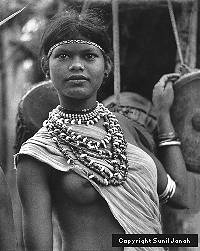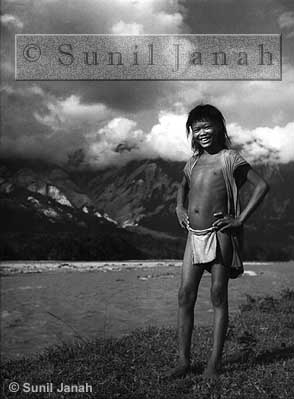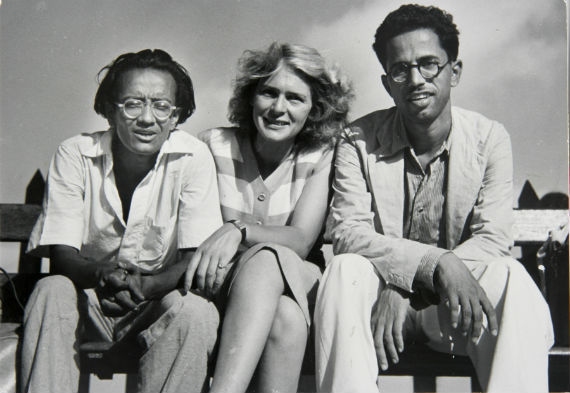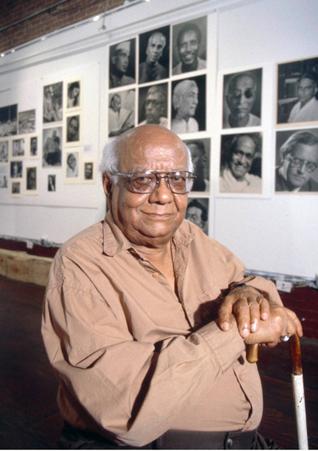 Sunil Janah, One of the stalwart figures in Indian Photography from the British Raj era passed away a few days ago (21st June) at the age of 94. Remembered most strongly for his powerful photographs of the Bengal Famine and portraits of the political tumult of the 1940s and 1950s, Janah was one of those photographers who was in fact a political activist with photography as his chosen tool for bringing social change, not unlike his contemporary Alberto Corda.
Sunil Janah, One of the stalwart figures in Indian Photography from the British Raj era passed away a few days ago (21st June) at the age of 94. Remembered most strongly for his powerful photographs of the Bengal Famine and portraits of the political tumult of the 1940s and 1950s, Janah was one of those photographers who was in fact a political activist with photography as his chosen tool for bringing social change, not unlike his contemporary Alberto Corda.
I was introduced to his Photography through his work on tribals in India. Though ethnographic in nature, the photographs from this work show the tribals in a distinctly non-condescending light, categorically avoiding any overtones of pity or superiority. 
Their ways, traditions, clothing as well as partial nudity, their tools and their life in general is photographed by Janah in a way that seems to make it appear healthy, whole, desirable – almost worthy of aspiring to. All the photographs are printed with beautifully sensuous tonality and separation of midtones (skintones) to give them a tactile attractiveness that resembles images from the fashion world. Most of the subjects in these portraits seem happy and confident in their gaze, posture as well as actions. This provides an important counter-balance to the documentary photography done by Janah’s contemporary British photographers and colleagues such as Margaret Bourke-White, that dealt with similar subjects.

Left to Right: Sunil Janah, Margaret Bourke-White, Rangnekar. In Bombay.
Here is a snippet from a very nice article by photographer Ram Rahman that was published in The Hindu yesterday about the life and work of this Legendary Indian Photographer.
Sunil Janah, the photographer whose searing coverage of the Bengal Famine and vivid political portraiture of the 1940s and 1950s helped chronicle a tumultuous era in the life of India, passed away at his home in Berkeley, California on June 21. He was 94 years old.
His wife, Shobha, passed away only a few weeks before. He is survived by his son, Arjun Janah.
Janah was born in Assam in 1918, but grew up in Calcutta. He was educated at St. Xavier’s and Presidency colleges in Calcutta. Like so many others at the time, he had joined the Student Federation inspired by left-wing politics. When the British lifted the ban on the Communist Party of India as it supported the Allied front against the fascist forces of Hitler and Mussolini, Janah caught the eye of CPI’s visionary general secretary, P.C. Joshi. At the time, Janah was a keen amateur photographer; Joshi recognised his talent and overnight persuaded him to abandon his English studies and travel with him and the artist Chittoprasad to photograph the famine raging across Bengal in 1943. The photographs by Janah published in the party journal People’s War brought him instant fame as they revealed to a shocked nation the horror of the famine.
Janah later moved with Chittoprasad to live in the Party commune in Bombay, where both were intimately associated with the Progressive Writers Association (PWA) and IPTA, the Indian People’s Theatre Association. Janah had become the most famous photographer in India by then and was sought out by LIFE magazine’s Margaret Bourke White, with whom he formed a unique friendship and working relationship in 1945.
You can read the full article here. In spite of being such a great artist and a world Famous Indian Photographer, his contribution to Indian Photography remains little known. It is quite sad that except for the The Hindu article, hardly any other news was published regarding Sunil Janah’s death in news papers in India. It is also an unhappy fact that the current generation of young photographers remains mostly ignorant of even his existence.

In an article by Roselyn D’Mello, published on artinfo, she quotes some of the reasons for this apathy towards Janah’s formidable photographic oeuvre as pointed out by Ram Rahman:
Rahman, who has been lecturing extensively on Janah’s contribution to the field of documentary photography in India, considers Janah’s work as “the defining epic document of the last decade of the freedom struggle and the first decade of free India – the Nehruvian years. “Janah remained a committed communist till his last breath, though not a party member,” notes Rahman.
That younger generations remain unaware of Janah’s oeuvre is largely due to Janah’s cynicism and bitterness over never being given payment, credit, or due for his photographs. He was particularly peeved at writer and art critic Mulk Raj Anand, Rahman says, who used his pictures in “Marg”, “pictures which educated an entire generation about India’s temple architecture and sculpture,” without receiving his due. “This bitterness made him a recluse in later life and led to the huge body of work being hidden from public view for decades,” Rahman says.
In ’98, Rahman managed to mount a huge retrospective of Janah’s work in New York, featuring 600 vintage prints. Although every attempt was made, Rahman says he was unable to persuade the Indian government to acquire Janah’s immense archive which has been sitting in his basement in Berkeley for years. In fact, the present government has been generally apathetic towards Janah’s legacy. This January, the government awarded him a Padma Shri, an embarrassing move considering the then Prime Minister Indira Gandhi had bestowed the honor on Janah back in ’74. The government finally upgraded the title to a Padma Bhushan, however, it had not yet been officially presented to Janah by the Consul General in San Francisco at the time of his death.
This kind of blatant disregard of our own history (photographic or other wise) and apathy bordering contempt of our own heroes is nothing new to India.  The irony is that many Indian photographers (me included) and probably Indians in general know more about the history of American photography, and have seen more photographs from even middle rung famous photographers from the US and Europe, while not knowing or having a chance to see the photographs from world class Indian Photographers, as they pass into oblivion without notice.
The irony is that many Indian photographers (me included) and probably Indians in general know more about the history of American photography, and have seen more photographs from even middle rung famous photographers from the US and Europe, while not knowing or having a chance to see the photographs from world class Indian Photographers, as they pass into oblivion without notice.